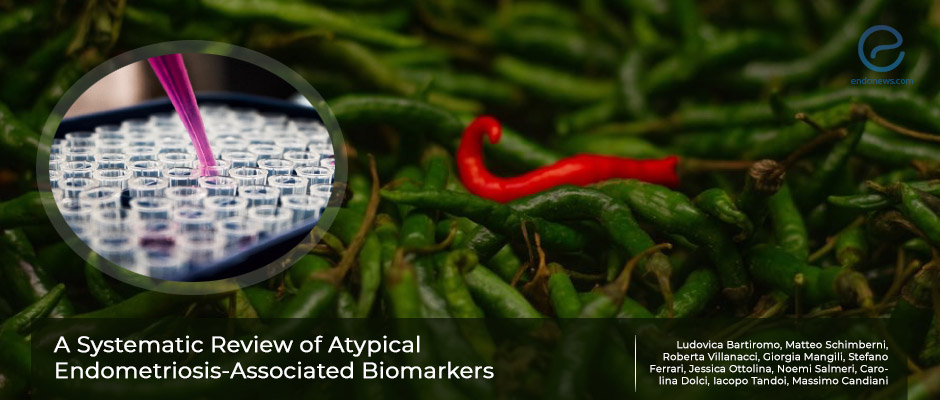A search for a marker to show the malignancy risk of endometriomas
Jul 12, 2022
Although many molecular targets have been proposed, none of them has such strong evidence to justify their systematic use in clinical practice.
Key Points
Highlights:
- For now, histological evaluation is the only way, and the need for serum markers still continues.
Importance:
- The review summarizes the markers that should be checked when atypic findings for endometriosis are present on pathological analysis.
What's done here:
- PubMed and Medline databases have been checked for the keywords: “Endometriosis”, “Atypical”, “Atypical endometriosis”, “Marker”, “Biomarker”, and “Atypia”.
- Only full-length, English-written manuscripts(case reports and research papers) up to July 2021 have been included.
Key Results:
- 39 articles that match the criteria have been reviewed.
- All studies showed data from the immunohistochemical analysis, and no study has been found that evaluates hematological or serum biomarkers for atypical endometriosis.
- The pre-malignant, “atypical” lesions have been described by histologic criteria, as large nuclei with moderate to marked pleomorphism, increased nuclear-to-cytoplasmic ratio, cellular crowding, and stratification.
- The most frequently detected mutations were ARID1A, genes involved in the PI3K pathway genes encoding for ER and PR, KRAS, and PTEN.
- Most of the studies have supported the role of the “two-hit” hypothesis for malignant transposition of endometriotic lesions. First comes from the oxidative stress related to hem and iron causing epigenetic mutations including ARID1A, and second from activation of the PI3K-AKT-mTOR pathway stopping apoptosis.
- BAF250a, Brahma-associated factor (BRG-)associated factor 250a loss has also been found as a precursor for ARID1a mutations.
- The continuing loss of ER and PR expression from endometriosis malignant lesions has been noted to imply that hormone receptor staining may be recommended as a marker for premalignant or malignant lesions in endometriosis.
- A reduced HNF 1-beta expression in AE as compared to malignant lesions has also been noted.
Limitations:
- The number of studies, and the low case numbers in each study limit the value of the results.
Lay Summary
The premalignant features and precursors that show the malignant potential in endometriomas are not well-known. In the systematic review conducted by Ludovica Bartiromo et al, the markers for malignant transformation have been analyzed and recently published in a recent issue of the International Journal of Molecular Sciences.
In the literature review, databases have been checked for the keywords: “Endometriosis”, “Atypical”, “Atypical endometriosis”, “Marker”, “Biomarker”, and “Atypia”. Only full-length, English-written manuscripts, including the case reports and research papers, have been included. PRISMA criteria have been used to overcome the bias factor. Thirty-nine articles that match the criteria have been assessed.
All studies showed data from the immunohistochemical analysis, and no study has been found that evaluates hematological or serum biomarkers for atypical endometriosis. The “atypical” lesions that were suggested to be premalignant, have been described by histologic criteria, as having large nuclei with moderate to marked pleomorphism, increased nuclear-to-cytoplasmic ratio, and cellular crowding, with stratification.
The most frequently detected mutations were ARID1A, genes involved in the PI3K pathway genes encoding for ER and PR, KRAS, and PTEN. Somatic-driven mutations in KRAS, PTEN, PIK3CA, and ARID1A have been also detected in almost 26% of lesions from deep infiltrating endometriosis nodules but no risk of malignant transformation has been shown.
Most of the studies have supported the role of the “two-hit” hypothesis for malignant transposition of endometriotic lesions. First comes from the oxidative stress related to hem and iron causing epigenetic mutations including ARID1A, and second from activation of the PI3K-AKT-mTOR pathway stopping apoptosis. The continuing loss of ER and PR expression from endometriosis malignant lesions has been noted to imply that hormone receptor staining may be recommended as a marker for premalignant or malignant lesions in endometriosis. A reduced HNF 1-beta expression in atypical endometriosis as compared to malignant lesions has also been noted. The low number of studies on this area limits the suggestive potential of found results and also the need for serum markers still continues.
Research Source: https://pubmed.ncbi.nlm.nih.gov/35457244/
atypical endometriosis malignancy risk markers

